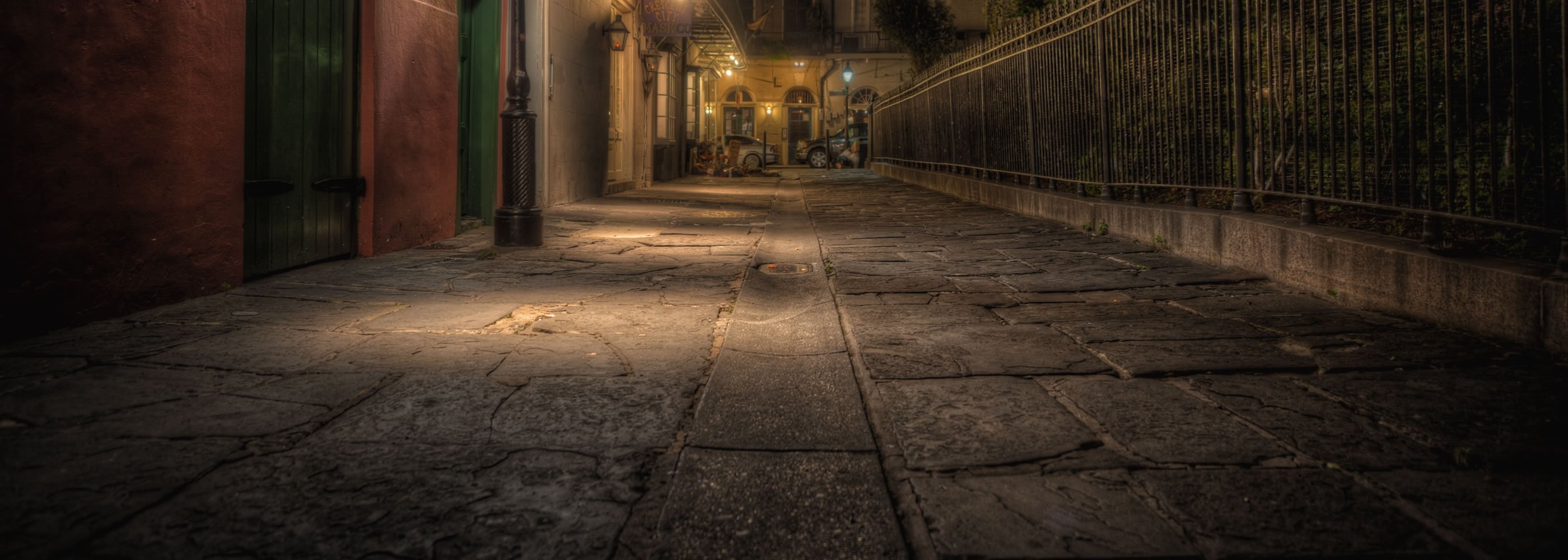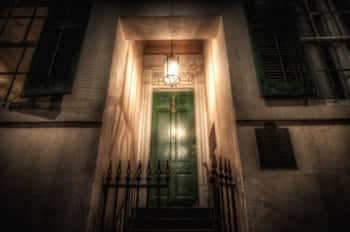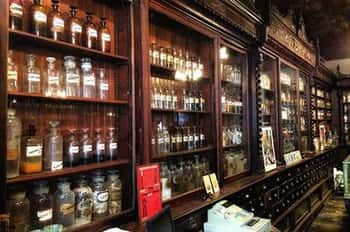
Settled between St. Louis Cathedral and the Cabildo, the quiet, cobblestoned Pirate’s Alley elicits a sense of nostalgia for days gone by. The stones beneath your shoes are uneven; jagged in some areas, smoothed in others. Cast-iron lampposts bracket either side of the alleyway, including one in the middle which marks the entrance to Cabildo Alley; all are slightly crooked, as if time has left its mark and the battle was a struggle. The middle lamppost boasts the red-and-white sign: “Quiet: Church Zone."
The time of the day marks the passage of time. In the morning, Pirate’s Alley is empty, haunting; by afternoon, local artists and vendors have camped out with their paintings clipped to the fence of St. Anthony’s Garden; by evening, the alley is illuminated only by the lampposts and Pirate’s Alley Cafe and Absinthe House.
It seems as if there is hardly a building along Pirate’s Alley which doesn’t have a great ghost story or two. Pirate’s Alley certainly seems to be one of the most haunted locations in New Orleans, which is why we go there on our Ghosts of New Orleans Tour.
Pirate’s Alley hasn’t always been officially called as such, but local New Orleanians have preferred that name to its real one, Rue Orleans since it was first laid out in the late eighteenth century. Measuring 600 feet long and 16 feet wide, Pirate’s Alley was never intended to be a main street with shops and business; instead, it was meant to act as a throughway, or as the Brits like to call them, snicket-ways.
For early New Orleanians, Pirate’s Alley created a passage between Chartres and Royal Streets alongside St. Louis Cathedral. By laying out such a path, locals did not have to take the time to walk over to St. Peter or St. Anne Streets. It was originally unpaved though the cobblestones seen today were added in the 1830s. Not until the 1980s when Jackson Square became a pedestrian mall did Pirate’s Alley become a main shopping hub.
Although Pirate’s Alley was added almost as an afterthought, it is positioned amidst some of New Orleans’ most historically significant buildings.
Standing tall and imposing next to Pirate’s Alley is St. Louis Cathedral. Though this is the third structure to have been erected on this plot of land, the first church was erected in 1727. It was named in honor of the French King Louis IXth, the Saint King. Interestingly enough, the Cathedral has been anointed as a Basilica today—but we New Orleanians crave consistency, so it continues to be referred to as St. Louis Cathedral. (Except for when the Pope or a Bishop is due to visit because, naturally, we must make ourselves as classy as possible for those seldom occasions).
The museum today consists of the Cabildo, the old Arsenal and the Creole House (Calabozo). The trio of buildings have been a major landmark in New Orleans since the late 18th century. This was the epicenter of colonial French and Spanish government buildings.
The Cabildo, which literally means Council, was the location of the colonial government. When the Spanish first arrived after the 1762 Treaty of Fountainebleau passed Louisiana from French into Spanish hands, they arrived to rebellion and anger. The Frenchmen were furious that they had been traded as an act of War (French-Indian War in the North) and had been uninformed of this treaty for an entire year. Naturally, they rebelled; naturally, the Spanish wished to put an end to this. They sent their best General, a man named Don Alejandro “Bloody” O’Reilly to squash the furor. He arrived in 1769 with 2,000 troops. After killing the first rebelling Frenchmen he came across, he invited the rest of the leaders of the French uprising to the Cabildo for a meal to “solve their problems.” Allegedly, the Frenchmen scurried right down and enjoyed themselves a grand old meal. At the end, however, Bloody O’Reilly stayed true to his name: he handcuffed the men and brought them to the intersection of Esplanade Avenue and Frenchmen Street where he executed them all.
(Fun Fact: The musically inclined Frenchmen Street is named after the Frenchmen who lost their lives against the Spanish in the 18th century).
Today, the Cabildo is one of the pride and joys of the Louisiana State Museum, housing hundreds of early colonization and 19th-century artifacts within its exhibit. The artifacts even include a bronze death mask of Napoleon Bonaparte—you don’t want to miss this!
The Arsenal is technically located along St. Peter Street, right off of Chartres Street. In 1836, the Louisiana Legislature mandated that a “state armory” was to be constructed on the property. For nearly a hundred years, the Arsenal contained all of the weaponry within the city for the military and city police forces.
When Union troops stormed into New Orleans in 1862 and occupied the city, the Arsenal served as the military prison and Federal Headquarters. Even later during the Reconstruction era, the Arsenal remained a highly sought after prize. For a period of three days in September 1874, the Arsenal came under control by the White League Democrats after they defeated the Metropolitan Police. Not until President Ulysses S. Grant sent federal troops was order restored within the city. In 1914, the Arsenal was gifted to the Louisiana State Museum.
The Calabozo stands on the back half of the Cabildo along Cabildo Alley. Walking along Pirate’s Alley, you will see three antebellum mansions with beautiful wrought iron galleries; however, these homes were only constructed in the early 1840s. Before that, the plot of land was used as the French Guard House and the Spanish Calabozo, or prison.
(Fun Fact: the 20th-century slang “calaboose” for prison is thought to have originated from the Spanish word “calabozo."
In 1924, the Monroe News-Star newspaper commented that “Pirate’s Alley, behind the Cabildo, was another interesting spot and on the walls of the courtyard, where pirates and other prisoners were lined up and shot, may still be seen holes where bullets were imbedded."
In reality, it is unlikely that any executions took place behind the old Calabozo. Executions were done in Jackson Square (the old Place d’ Armas) or within the interior courtyard of the Cabildo itself. Nevertheless, the Calabozo has certainly held a famous prisoner or two before it was demolished in 1837.
St. Anthony’s Garden behind the Cathedral was originally a burial ground. Soon enough, it was decided that more space was needed, and many of the bones were exhumed and re-interred in St. Louis Cemetery #1 on Basin Street. (Just as many bones were “lost” or never moved, however). A garden was then intended for the plot of land, but its purpose quickly took a new turn. For a period of nearly fifty years, the space that is known as St. Anthony’s Garden (or the Cathedral Garden) was actually a designated location for illegal, deadly duels. Only during the Civil War, when duels fell into disfavor, was the site made into the garden it was intended to be.
Close Encounters: Between St. Louis Cathedral and Pirate’s Alley Cafe and Absinthe House, there is only a 14-foot difference. (How many other places can you think of where religion is less than twenty feet away from a bar? Welcome to New Orleans, my friends).
One of the most historic locations on Pirate’s Alley is the Faulkner House Books store. Located right in the middle of Pirates Alley, this bookstore was once home to William Faulkner. Faulkner stayed in New Orleans in the 1920’s. He even wrote his first novel, Soldier’s Pay while staying in this house.
It is rumored that the ghost of William Faulkner still resides in this house. There have been many reports of people seeing the ghost of Faulkner still sitting at his writing desk, which is located in the store. In addition, ghostly smells of pipe smoke can sometimes be smelled wafting through the bookstore. It is well known that Faulkner liked to smoke a pipe while he wrote. Is this apparition that of William Faulkner, or someone else? On our Ghosts of New Orleans Tour, we spend time talking about the ghosts which haunted Faulkner House Books.
If you are walking through the Pirate’s Alley area, make sure you stop into Faulkner House Books. They have a great selection of books on New Orleans and our history.
Ever heard of the infamous pirate Jean Lafitte? Well, while Jean himself was never imprisoned, his brother Pierre certainly was. In 1814, in the final days leading up to the Battle of New Orleans during the War of 1812, it is said that Jean Lafitte negotiated his brother’s “escape" from prison with General Andrew Jackson along Pirate’s Alley. In exchange for Pierre’s release, Jean Lafitte agreed to aid General Jackson in the fight against the British. Legend has it that without the pirates Jean Lafitte provided for the American military, General Andrew Jackson would never have triumphed during the four-part battle in the winter of 1815.
But did Jean Lafitte really operate out of Pirate's Alley? Legend says yes.
I know, it has quite the romantic and fantastical ring to it, doesn’t it? Over the years, there have been many attempts to argue that Lafitte and his pirate brethren operated a base in the alleyway along St. Louis Cathedral. Some people have even claimed that the fence enclosing St. Anthony’s Garden behind the Cathedral was once a place where pirates sold bootlegged goods to the citizens of New Orleans.
While it is possible that this occurred, there is no historical evidence that proves it. Jean Lafitte’s quick wit and savviness is legendary, and so it seems rather implausible that he would choose to conduct any business in an alley that was bracketed not only by the Church but also by the government building and the Old Parish Prison.
An idiot, Jean Lafitte was not.
So, although it is quite fun to think that Pirate’s Alley earned its name from the infamous pirate, that slice of history is probably nothing but a tall tale.
However, it must have been enticing enough. In 1925, the famous novelist William Faulkner moved into the second floor of 624 Pirate’s Alley. It is said that that he was lured in by the tales of Jean Lafitte and his interactions with General Andrew Jackson, but also by the haunted tales told about the Old Parish Prison, or the Calabozo. (Check out our Ghost Tours to learn more about this!)
Many people have reported seeing the ghost of Jean Lafitte walking up and down Pirate’s Alley, but is it really him? Another legend states that it is not actually Lafitte’s apparition which is spotted in the early mornings, but another by the name Reginald Hicks.
As the story goes, Hicks was traveling on a ship in the Atlantic when the vessel was captured and ransacked by pirates. He was just a boy, and the pirates opted to take him with them and raise him. By the time of the War of 1812, Hicks had become a strapping first mate aboard a pirate ship. Allegedly, Hicks was one of the men to travel with Lafitte to go meet General Andrew Jackson; it was during his time in New Orleans that he had the opportunity to meet the Marie Angel Beauchamp, a beautiful French Creole girl. They fell desperately in love, but all too soon they discovered she was pregnant with child. Hicks refused to have his child be labeled illegitimate, and he and Marie immediately sought out a priest to marry them. But they had limited time—the War was rapidly approaching—and they could only think of a German minister that was, interestingly enough, doing time in the Old Parish Prison. Hicks and Marie begged the prison guard to let them in; although they were married, the German minister was forced to do by the iron gate along Pirate’s Alley. Their marriage was officiated by the Church, and papers were drawn at the Cabildo, too.
But what happened to Hicks after? It is thought that he was killed during the War, leaving his beloved Marie a widow so early into their marriage. Today, many couples choose to get married in Pirate’s Alley just as Reginald Hicks did. But his ghost? It is said that Hick’s spirit still haunts Pirate’s Alley. Early in the morning, people have reported hearing wedding bells and the sounds of ghostly laughter even as the alley is completely empty. One has to wonder: Is it the pirate Hicks? And if so, is he still searching for his wife, even after death?
In the early colonization period, a Capuchin monk, Pere Dagobert, arrived in the recently settled New Orleans. As a pastor at St. Louis Cathedral (then, St. Louis Church), Father Dagobert was a joyous man who was quite loved by the congregation.
However, when Louisiana was given to Spain, the French in the city began to revolt. (See Cabildo Section Above). After Bloody O’Reilly executed the Frenchmen who had rebelled, he refused to allow the men to be properly buried, as Catholic doctrine dictated. Father Dagobert refused to allow this to happen to the men.
In the middle of the night, Father Dagobert, along with the help of two other priests, obtained the bodies of the dead Frenchmen. They held a proper, though secret, burial at the St. Louis Church before interring the dead in St. Louis Cemetery #1. Whether the Spanish governor and Bloody O’Reilly ever discovered this treason is unknown within history. But it is safe to say that Father Dagobert is still watching out for those around his old stomping grounds—or his ghost is, anyway.
People have reported hearing ghostly singing within the Cathedral, but also along Pirate’s Alley, too. The disembodied voice of a male has been reported in the same area. But don’t worry: Father Dagobert’s ghost is friendly, just as the man was himself.
When you look at a haunted location, one of the first thoughts that come to mind is ‘Why is this place so haunted?’ What traumatic events happened here? Who was attached to this property? All of this questions, when answered, can help you start to unravel the mystery of who might be haunting a location.
When we started researching the ghosts of Pirate’s Alley we looked into the history of the buildings which line the alley. Well, it turns out that one of the old Prisons in New Orleans was located along this alleyway. While researching the prison on Pirate’s Alley, we uncovered many ghost stories that were told by prisoners. Now, that is an amazing find. Not only did we confirm that many of the ghosts and hauntings on Pirate’s Alley can be attributed to the Prison, but we also found first-hand accounts from the Prisoners themselves about the hauntings on Pirate’s Alley. On the Ghosts of New Orleans Tour, your tour guide will tell you a number of these ghost stories, including one that was documented by one of the wardens of the prison.
The Prison isn’t around anymore, however, it roughly occupies the area of Faulkner House Books and the surrounding areas. If you look on the outside of Faulkner House Books you will even find a marker for the old Prison.
Pirate's Alley is always worth a quick visit while spending time in New Orleans
For those hoping to hear more about the ghostly lore of the Pirate's Alley, check out our Ghosts of New Orleans Tour which makes a tour stop in Pirate's Alley on a nightly basis, starting at 8 pm. You'll hear the whole story about the ghosts and amazing history of Pirate's Alley.

Was this the site of a grizzly mass murder?

New Orleans' most haunted Cemetery

Who haunts this museum, and why?